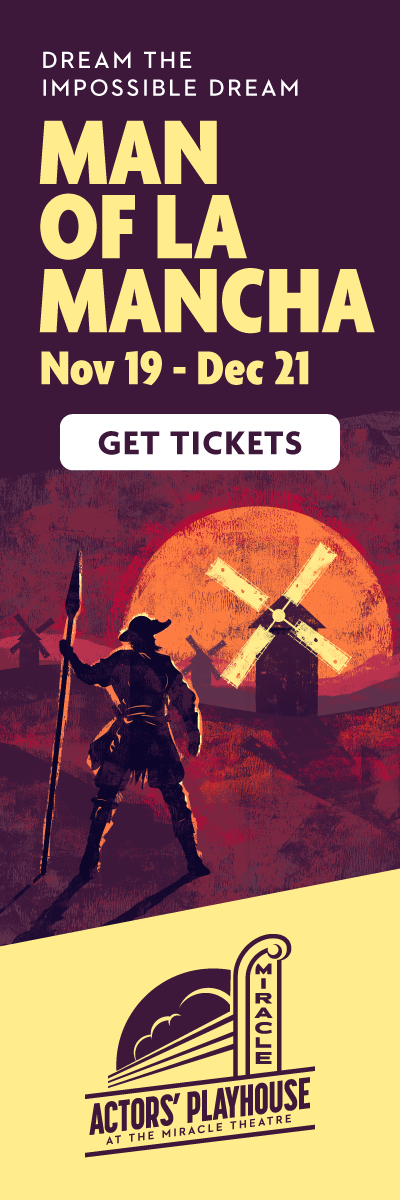
Don Quixote and Sancho (E.L. Losada and Jose Luaces) astride their horses in Actors’ Playhouse’s Man of La Mancha (Photos by Alberto Romero)
By Bill Hirschman
The classic is precisely 60 years old, but Actors’ Playhouse re-re-production of Man of La Mancha resounds loudly with undeniable resonances today.
In our times as troubled as Cervantes’ 16th Century Spanish Inquisition, La Mancha remains a relevant clarion call for us to remain steadfast in our integrity to the principles we hold – regardless of the cost.
The musical remains an affecting paragon not simply because of its incomparable score, but because its script is far more even-handed and clear-eyed than you remember about the virtue and the price tag of pursing a righteous quest literally regardless of whether you win or lose in a dark world.
This third run by the Playhouse is blessed with arresting acting, adroit direction, engrossing design elements and a superb band all integrated into a powerful experience, ranging from the robust production to its effect on the audience.
While the original creators and their successors do not optimistically pretend a triumphant outcome is inevitable in the future, they bravely plant a seed of hope that our inner nature may prevail.
Playwright Dale Wasserman’s premise is author-poet-dramatist Miguel de Cervantes imprisoned in a dungeon common room for having taxed a church and he is awaiting trial before the Inquisition. Meanwhile, his fellow inmates try him, threatening to burn his manuscript of a work in progress Don Quixote. To rescue it, he uses the prisoners to stage scenes from his novel tracking the journey of the slightly demented old Alonso Quijana who believes himself a knight errant.
With his loyal servant Sancho Panza at a muleteers’ tavern (well, he thinks it’s a castle) Quixote sees the life-eroded serving wench/prostitute Aldonza as the ultimate fair lady Dulcinea.
Eventually, his potential son-in-law forces him to see reality. But Cervantes creates at the last minute a revivification that is one of the most moving and uplifting finales in musical theater.
The plot is elevated several levels with the music of Mitch Leigh (virtually his only major success other than as a jazz musician and writing the jingle “Nobody Doesn’t Like Sara Lee”) and lyricist Joe Darion. The original was blessed by Albert Marre’s direction of career-marking performances of Richard Kiley and Marre’s wife Joan Diener (Kismet).
This cast deftly directed by David Arisco is a miraculous assemblage of solid actors, but every single last one also delivers voices that soar in power and emotion that overwhelm.
Particular honor is due Henry Gainza’s choreography, which launches from the very first moment with a swirling, foot-stomping celebration of movement. Gainza, who also does duty as the Padre, is a veteran both locally and nationally, but this marks his first full assignment as a choreographer and co-director. The comic battle with muleteers was staged by Lee Soroko.
Of course, the essential element is an actor with the sonorous baritone, the acting chops to alternate between a middle-age dreamer and an elderly madman, and an innate charisma to play the double-faceted hero. This production is blessed with the return home of E.L. (Euriamis) Losada, once a regular at the late New Theatre and the Playhouse in Coral Gables two decades ago.
Like much of this cast, he looks a shade younger than you expect although he is actually precisely the middle-40s age that Wasserman specified. But he inhabits both characters with acting skill and emotional firepower that propels the evening to an outstanding level. And, of course, there is his voice that nails every number, especially the anthem “The Impossible Dream.” His voice ages whenever he becomes Quixote and seamlessly back again as he narrates and comments. His Cervantes mixes a clear love of storytelling theater and humor.
But my personal favorite moment in any production is the speech when Cervantes pushes back at his nemesis’ insistence that this madman must “come to terms with life as it is.” Losada invests Cervantes’ glorious response with a remarkable reading listing the various hells he has faced and then retorts “And maddest of all, to see life as it is and not as it should be.”
And Gaby Tortoledo. She is quickly becoming one of the region’s most memorable actresses – both in plays and musicals. Arguably a shade too gorgeous to be a tavern prostitute (the actresses in this part always are), her performance is mouth-dropping from her inhabiting the engrained pain and world-worn cynicism to a voice that can range from stratospheric heights down to a rusty saw’s growl, both in her fury-engorged “Aldonza.”
 As much as we laud the script, the original creative staff didn’t trust their 1965 audience could deal with the serious tone throughout. So they made Sancho Panza a runaway from a 20th Century vaudeville act starring Yiddish theater veteran Irving Jacobson. The writers believed that they needed some relief and they never changed their minds over the decades, even inside the growing drama of the penultimate dramatic scene. So credit Arisco and praise actor Jose Luaces for lightening the journey with a way over the top performance that the creators sought.
As much as we laud the script, the original creative staff didn’t trust their 1965 audience could deal with the serious tone throughout. So they made Sancho Panza a runaway from a 20th Century vaudeville act starring Yiddish theater veteran Irving Jacobson. The writers believed that they needed some relief and they never changed their minds over the decades, even inside the growing drama of the penultimate dramatic scene. So credit Arisco and praise actor Jose Luaces for lightening the journey with a way over the top performance that the creators sought.
But the entire assemblage is first-rate including Paul-Louis-Gonzalez as The Governor and The Innkeeper, Gainza as The Padre (with one of my favorite songs “To Each His Dulcinea”) and Michael Focas as Dr. Carrasco, the antagonist. Focas doesn’t get too much to sing, but when he does, the balcony shakes.
The band led by conductor/music director Bruce Barnes envelops the audience with a note-perfect embrace of a half-dozen idioms from the plucked guitar to the pulsing percussion to the accenting flute and piccolo and especially the proclaiming brass.
On a sensory level, admiring kudos are due the entire creative team. Start with K. April Soroko’s multi-level stone dank dungeon with parapets, arches and iron grills. Subtle oft-changing lighting design by Eric Nelson underscores the emotional shifts in the environment and the changes in the plays evolving tones.
Master costumer Ellis Tillman garbs the community in age-decayed ragtag, plus a dazzling mirror-encrusted armor for the ultimate villain. The sound design by Reidar Sorensen perfectly balances the voices and the orchestra, although at Sunday’s matinees, the already vigorous band and vocal performances arguably could be heard in Hialeah. On a scale of 1 to 10, it topped 11 ½. Stage managing jobs on this intricate show were mastered by Naomi Zapata and Lilly Paez.
The band was Barnes on keyboards, Ranses Colon on a foundational bass, Alejandro Gonzales on a variety of percussion, Maciej Pietraszko on trombone, Doug Michels on trumpet and fluegelhorn, Benjamon Eisenberg on bassoon oboe and clarinet, Alyssa Mena on flute and piccolo, and Alvaro Bermudez. Seriously, these folks deserve a special Carbonell and Silver Palm.
Other actors deserving their curtain call include Michael Hunsaker, Jonathan Eiseke, Seth Trucks, Hugo E. Moreno, Joey Rodriguez, Esoli, Jeremy Seveloitz, Sofia Porcel, Carolina Ordonez, Lauren Horgan, Joline Mujica, Sara Grant, Luis Otamendi and Corey Vega.
Some odds and ends observations: A majority of the cast was intentionally cast with Latino actors. There is an attention to detail including when Quixote’s lance breaks in two during the attack on the windmill; later it’s top half is replaced with a branch.
Usually, the show is done without an intermission, but Arisco felt his audience would have trouble with sitting still that long so he halved the show during the song “Golden Helmet of Mambrino.” But he ingeniously opened the second act with the finale of that chorus-backed rousing number. He also had Aldonza occasionally mutter phrases to her customers in Spanish.
If your familiarity with the score comes from the original cast album, be warned that Dulcinea’s name is pronounced here with an almost silent “L,” which apparently is one of several options.
History lesson: The show has been beloved since bowing in New York City 60 years before on the date of this production’s first Saturday night. First performed in a temporary theater in Greenwich Village, it was notable for being staged on a deep thrust stage. It played 2,328 performances, went on tours and has been revived often in regional theaters, although not on Broadway since 2002 with Brian Stokes Mitchell. And Maltz Jupiter Theatre has slated it for March.
Man of La Mancha has been a touchstone for Actors’ Playhouse as its first production ever in 1988 and then became the first offering when the company moved to its current home on the Miracle Mile in Coral Gables.
As fine as this is being gifted, there does seem to be a miniscule shortfall from what your memory may have cherished. Perhaps you have seen it so often that this may seem a hair presentational when you know what is coming so well that you are fighting not to sing along. It’s like listening to a favorite piece of classical music you know by heart. And then, suddenly, thankfully, it once again overwhelms you with its muscle and passion.
This isn’t a notably different vision of the piece, but if you love the show or if it has been a while since you have seen it, you can’t ask for a better edition than Actors’ Playhouse’s production keeping the dream alive.
Man of La Mancha plays through Dec.1 at Actors’ Playhouse, 280 Miracle Mile, Coral Gables. Running time roughly 2 hour 20 minutes including one intermission, Evening performances 8 p.m. Wednesday- Saturday, 3 p.m. Sunday. A special weekday matinee Wednesday, November 26 at 2 p.m. Tickets $40-$100. Call (305) 444-9293, visit www.ActorsPlayhouse.org, or at the box office. The theater offers 10 percent off all weekday performances for seniors and $15 student rush tickets 15 minutes prior to curtain with identification.














 A PaperStreet Web Design
A PaperStreet Web Design
